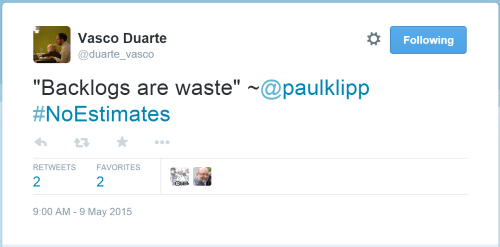The new Management 3.0 #Workout book is already available in PDF, Kindle and ePUB versions.…

Backlogs Are Not Waste
To some people, to-do lists and product backlogs are waste. I disagree. I see them as repositories of ideas and options.
There is nothing wasteful about the concept of a backlog. A backlog itself is not waste. What matters is how people use them.
Wish Lists
When it comes to books, I have a wish list the size of a planet. I not only enjoy reading books; I also enjoy searching books. I check best-books list, top 100 lists, annual awards, reviews and ratings, weekly new releases, and references in books to other books. Any potentially-interesting book titles I find, go straight onto my giant wish lists.
Obviously, I won’t be able to read all those books. A wish list is a list of Could-Haves. I compare my wish lists with a landscape. I find it useful to have a vague idea of the entire landscape, when choosing my path through those mountains and forests of books. Not having an overview of the terrain would mean that each step is a blind one.
Sure, sometimes reading a random book, as an unexpected sidestep, can be enjoyable. But my time is my most precious resource. I want to spend most of it being mindful of my options.
Checklists
When it comes to writing books, I am known to work with extensive checklists. A checklist is a list of Must-Haves. Every book is a different project, and therefore, every checklist is different from the previous one. But my checklists always contain items such as “Start with a story”, “Insert silly jokes”, “Add all literature references” and “Check for double spaces”.
The nature of a checklist seems like the opposite of a wish list. With a wish list, the idea is to do some of the items on the list. Even if you picked only one item from the entire list, if the item was a perfect choice, the wish list counts as a success. With a checklist, however, you must do all items. Even if you forgot only one item from the entire list, if forgetting the item causes you trouble, the checklist counts as a failure.
Backlogs
So what is a to-do list then? Is it a wish list or a checklist? And what about so-called product backlogs, which are basically the to-do lists for development teams? Are they mainly Could-Haves or Must-Haves?
Well, I’ve shown you before that I use Remember the Milk as my to-do list. For example, everything that I ever wanted to do in terms of marketing the #Workout book, is on a project in Remember the Milk. And I can tell you honestly, I’ve done about half of the items on that list. Has my list failed? Absolutely not. In the first six months, I sold more copies with this book than I did with the first one. In other words, all items on my to-do list were options. They were nothing more than ideas. That means, my to-do lists are wish lists.
In my opinion, with your product backlog, it should be the same. You should treat your backlog like a wish list. It is an overview of the landscape of your options. Sketching the landscape enables you to pick the most promising path for your project. And it allows you to remember what alternative paths are available to you when the current one doesn’t satisfy you.
Your supermarket shopping list counts as a checklist. Your product backlog counts as a wish list.
Creativity
There is another important reason to keep lists: The science of creativity suggests that the most innovative people are those who gather ideas from many sources and turn them into repositories of inspiration. I not only have lists of books; I also have lists (or actually unsorted collections) of quotes, articles, images, half-baked business ideas, and large file hierarchies full of junk from earlier failed and unfinished projects.
Research confirms that creative people thrive in environments that are a little bit messy, where there’s just enough background noise to allow receptive brains to make serendipitous connections between unrelated ideas. The whole point of innovation is to create something new out of things that already exist. There’s not much chance of that when you don’t have any raw materials to play with.
And because our brains are not optimized for memory, it is useful to have some tools around us that allow for limitless storage of junk. Those who are familiar with Getting Things Done will recall that it is a central theme of David Allen’s productivity method: get all the clutter out of your head and into a repository, where you can browse through the ideas whenever you want.
Inventory
Repeatedly, I’ve heard people say that “backlogs are waste because they are inventory”.
I disagree.
(Note: I use this picture quoting Vasco Duarte and Paul Klipp only as an example. I’ve seen the same comment many times over the last few years.)
My wish list of books is not inventory. It is an overview of options. Only the books that I actually bought, and that are still sitting in my book case unread, could be qualified as inventory, because I invested in them. (But I actually still consider them to be options, and a nice decoration of my living room.)
The same applies to your product backlog. A backlog is only “waste” when you treat it like a checklist, instead of a wish list, and then forget to process half of the items on the list. Committing to do something, and then not doing it, is potentially wasteful behavior. It wastes people’s time, energy and money. But outlining your options, and writing them down because your memory is not equipped to remember lists, is actually smart, not dumb.
Furthermore, telling developers and designers to always prune and clean up their lists of half-baked ideas is like imposing a clean-desk policy on creative workers. It reflects a mechanical view of productivity, and it might be the silliest thing you could ask from people who are expected to be innovative. If they are not allowed to keep lists of ideas, how will you expect them to create innovative products?
Treat your backlog as a messy repository of half-baked ideas, instead of a sanitized production queue.
There is nothing wasteful about the concept of a backlog. A backlog itself is not waste. What matters is how people use them. Creative workers need tools to store their ideas and to remember their options. Only factory workers should be expected to keep their inventory low and their machines clean.
Telling people that backlogs are waste is not helping anyone to be more innovative.
photo credit: (c) 2013 Barnyz, Creative Commons 2.0







